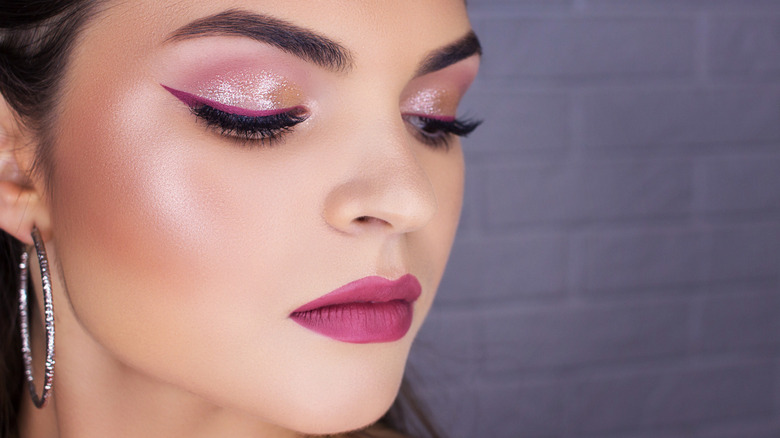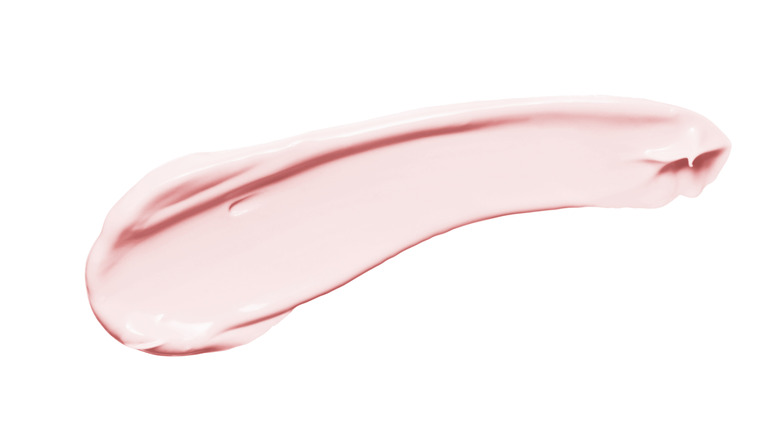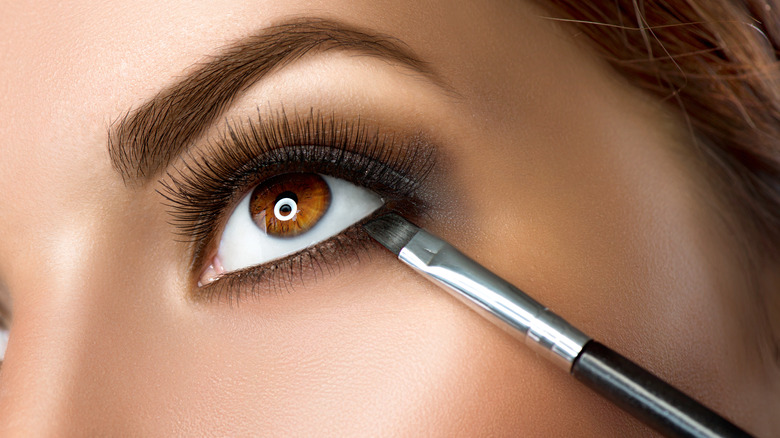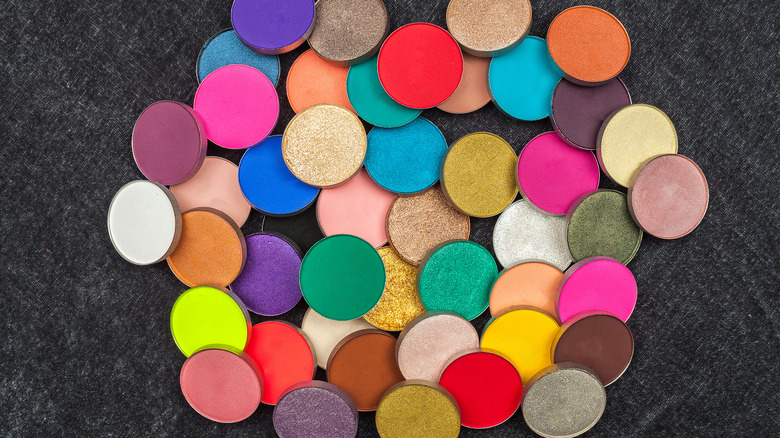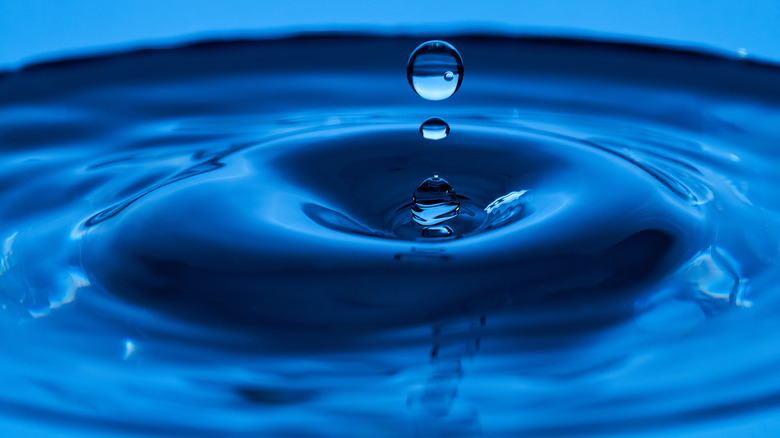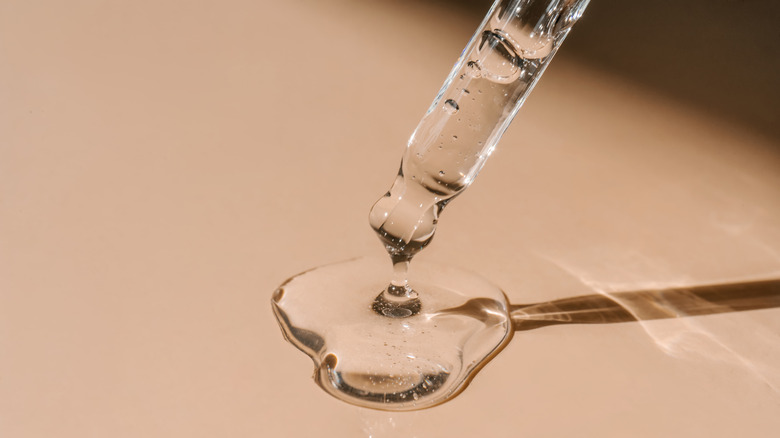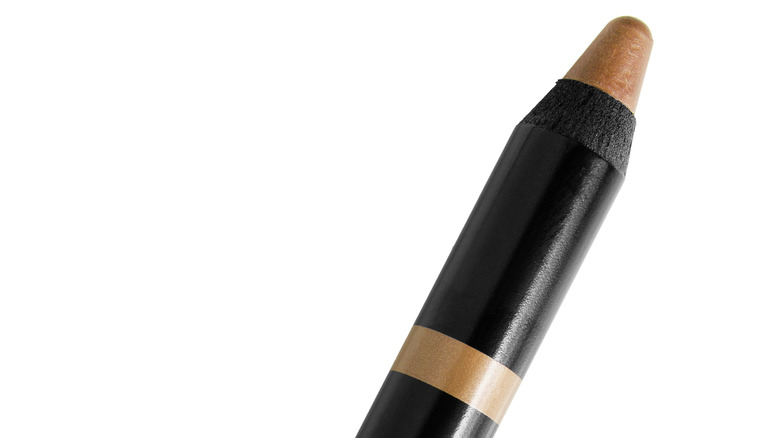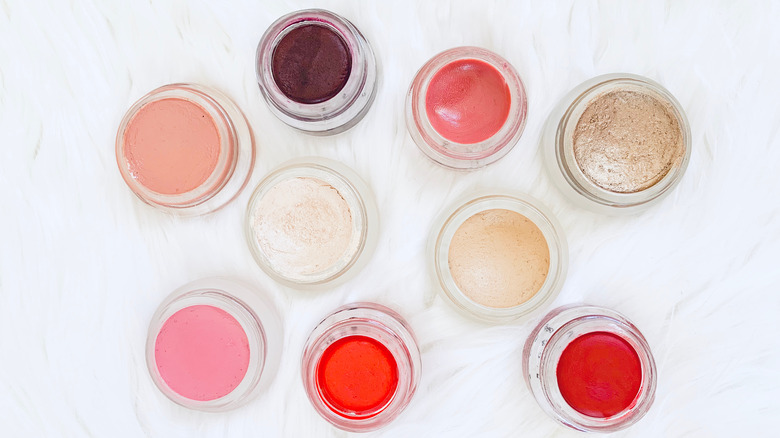7 Tips For Turning Eyeshadow Into Eyeliner
Eyeliner can be intimidating. There is unspoken pressure to get it just right, but more often than not you may be faced with mistakes you need to clean up. But even when it's not waterproof, eyeliner can be difficult to remove without ruining the rest of your makeup. Makeup artists make it look so easy by covering mistakes with concealer, but those are tricks of the trade that are the result of years of practice. Unless you started slathering your eyes with dark liner all the way back in middle school, you probably don't feel like a pro now.
A simple way to avoid eyeliner mishaps — and to also suddenly have way more shades of it — is to reach for eyeshadow instead. In fact, all of your favorite eyeshadows can double as liners. Simply prime your eyes, grab a trustworthy makeup brush, and consider the following helpful tips for getting the most out of your powder, cream, and everything-in-between shadow pigments.
Always use primer
The key to a vibrant long-lasting eyeshadow-as-liner look — whether your eyelids are dry, textured, or on the oily side — is a good primer. It works as a base for your products, allowing the pigment to adhere to a smoother surface. "It extends the life of your hard work so you can take your look from morning to night, and not have to worry about faded eyeliner flicks or eyeshadow creasing," makeup artist Savannah St. Jean told Byrdie.
Makeup artists swear by this technique, so if it seems like your lids struggle to hold onto shadow, but heavy-duty eyeliner is either too much fuss or too difficult to apply, better your chances of achieving the look you want with a good primer. Primer can be particularly important if you want to make a bright color pop, or if you're hoping for overall makeup longevity. Darling Magazine's beauty editor Francesca Giaimo spoke to Bustle about eye priming, saying "it especially improves the look and longevity of powder eyeshadows."
Glossier recommends these popular and reliable options on their blog Into the Gloss: Urban Decay Primer Potion, Too Faced Shadow Insurance, Nars Smudge Proof Eye Base, MAC Paint Pots, and NYX Eye Shadow Base.
Choose the right brush
The right brush makes applying eyeliner easy. Depending on the level of detail you'd like to achieve, the right brush size and shape may vary. On season 4, episode 4 of the BBC's competition series "Glow Up: Britain's Next Makeup Star," judge and esteemed MUA Dominic Skinner mentioned that lengthy and intricate line work is best obtained by a long, thin, pointed brush. "That's the trick to doing precision eyeliner work," he said.
A flat definer brush, on the other hand, is great for straight, larger areas, like the lower lash line. "Flat, dense brushes ... will deposit strong, intense color," celebrity makeup artist Michael D. Patterson told makeup.com. And a sharp, pointed angle brush allows you to dip into a shadow and simply draw directly on your eye, no product mixing needed. You'll get that softly painted smoky look with very minimal effort.
MasterClass lists world-famous makeup artist Bobbi Brown's favorite eyeliner brushes as the Eye-Contouring Brush by Chanel, the 202 Microliner Brush by Smith Cosmetics, the 212 Tightliner Brush by Smith Cosmetics, the E68 Line Perfector Brush by Sigma Beauty, and the M433 Pointed Liner Brush by Morphe. Brands also make brushes with uncommon handle shapes and angled grips, so powder, cream, gel — you name it, there's a brush for it. The trick is figuring out what works best for you.
Express your personality with powdered color
Turning powder eyeshadow into eyeliner creates a softer look. Of course, some shades lend themselves to this better than others. While it can be a good idea to start with a palette that suits your eye color and personal style, you can also use this opportunity to experiment with color theory. Branch out and experiment — there are no rules.
Figuring out what colors will complement your eye color and undertones is supposed to be as simple as looking at the color wheel. Invented by Isaac Newton, the color wheel demonstrates the relationship between shades on the overall color spectrum (via Canva). Complementary colors are hues that make each other pop, and choosing ones that align with your eye color makes for a very intentional-looking liner.
Take blue eyes, for example. According to Harper's Bazaar, celebrity makeup artist Ricky Wilson recommended orangey-bronze shades for making blue eyes steal the show. "This is because orange is the opposite of blue on the color wheel, and when you place complementary colors side by side they become more vibrant." Of course, sometimes you'll want a little more drama. Another option for blue eyes is a deeper shade of navy. "Black can appear too harsh on blue eyes, but the hint of blue in navy brings out this eye color even more," makeup artist Nick Barose told Harper's Bazaar.
Up the intensity with water
If you're new to makeup experimentation, you may not realize the power a simple drop of water holds. It's easy to use, readily available, and doesn't cost extra money. Simply grab a cup and your preferred palette and experience the intensely pigmented magic of wet powders.
L'Oreal Paris lists H2O as the first medium to try when trying to get more mileage out of your eyeshadows. It transforms the texture of the shadows into something entirely new. When using water, shadow sticks to the brush and applies to the skin with watercolor-like ease. And water and powder are much easier to remove than intense, long-lasting liquid liners should you make a mistake. Additionally, the color payout you get when adding water is more striking, and wait until you try it with metallics — you'll be wowed.
You can control the consistency of your product with the amount of water added, but a paste-like substance that is reminiscent of chalk is what you should look for as you start your powder-eyeshadow-to-eyeliner adventure (via L'Oreal Paris).
Experiment with other mixing mediums
Mixing medium is actually a pretty broad term. You can purchase one of the many options specifically made for this purpose, or you can get creative. Micellar water and setting sprays function as perfectly good carriers for all your powder-shadow-to-eyeliner needs. Eye drops can even be used in a pinch, just don't overdo it. "The active ingredient in the drops is a drug, which you shouldn't be putting too much of on your skin," cosmetic chemist Randy Schueller told Allure.
Micellar water works very similarly to regular H2O by creating a watery liquid liner out of any eyeshadow in your collection. The hack was popularized by TikTok influencer Monet McMicheal, and has now been tried by many a blogger and Instagram MUA.
If you're looking for something a bit more heavy-duty, go for setting spray. Cosmetic chemist Dr. Michelle Wong, of the skincare blog and YouTube channel Lab Muffin Beauty Science, said polymer sprays create a budge-proof film because they are often dissolved in some type of alcohol solvent, which then evaporates, leaving behind a sturdy layer of makeup protection.
Test out eyeshadow sticks
If you haven't used an eyeshadow stick as eyeliner yet, you should definitely try it, as the application is quite similar. "This is the ultimate formula for the on-the-go person," celebrity makeup artist Michael D. Patterson told makeup.com. "It's so easy to apply that anyone can create a quick eye look on the train or in your car (but not while driving, of course!)."
Professional makeup artist Nina Park demonstrated three different ways to use eyeshadow sticks (via Juice Beauty). First, she used a small brush to create a thick liner on the lower lash line, revealing a smoky, more dramatic effect. In the second look, she pulled out a flat definer brush to blend and bring the edge of the product to a vibrant, winged-out point — just like a traditional liquid liner. And lastly, she used the cream shadow stick as a highlighter. Don't be fooled by the name of a product. As long as it's safe for the eyes, it's eyeliner.
Give potted cream eyeshadows a try
Is there even a difference between cream shadows and eyeliners? Remember, don't get hung up on the name of a product. You can use whatever you want wherever you want. Potted shadows offer a variety of unique finishes and are available in colors that are not often marketed as liners. You don't have to just stick with matte formulas either; try experimenting with shimmer and glitter.
Celebrity makeup artist Nick Barose stands by using a good cream shadow as eyeliner. When asked by Harper's Bazaar, he recommended you stamp the product as close to the lash lines as you can, "then smudge it out around the eyes."
Cream and gel potted shadows are extremely flexible products, just as capable of producing a sheer wash of color on the lids as they are of being a striking, graphic eyeliner. "The versatility of this texture makes it a fit for any makeup situation," said New York City-based professional MUA Michael D. Patterson to makeup.com. "It's able to walk the line to be used as a base; it can create a quick office eye or a full-on glamazon look and even be used as an impromptu eyeliner."
